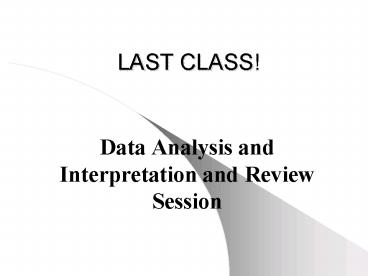LAST CLASS PowerPoint PPT Presentation
1 / 13
Title: LAST CLASS
1
LAST CLASS!
- Data Analysis and Interpretation and Review
Session
2
Quasi-Experiments
- Involve some form of intervention and a
comparison group, but they lack the control found
in true experiments. - No randomization
- Common form of quasi-experiment
- One-group pretest-posttest design
3
Nonequivalent Control Group Design
- Two conditions
- A group similar to the treatment group serves
as a comparison group. - You obtain pretest and posttest scores from
individuals in both the treatment group and the
comparison group.
4
Additive Effect of Selection and Maturation
Pretest
Posttest
5
Additive Effect of Selection and History
- The Local History Effect one group of third
graders may have gotten new books, or may have
gone on a special field trip that really inspired
them to get more involved in learning.
6
Other Possible Threats to Internal Validity not
Controlled for in the Nonequivalent Control Group
Design
- Observer bias
- Contamination
- Hawthorne Effects
7
What about external validity?
- Nursing home example
- Plants and happiness.
- How do we know if these findings have external
validity?
8
Program Evaluation
- Provide information to administrators of
organizations regarding what services to provide
to whom and how to best provide them. - Needs
- Process
- Outcome
- Efficiency
9
Is this stuff science?
- Yes, Applied research is linked to basic
research! - By conducting applied research (program
evaluation, etc) you observe phenomena in your
environment and can then scientifically (using
basic research) investigate those phenomena to
determine more precisely what is happening. - Applied Research ?? Basic Research
10
Chapter 12 Data Analysis Interpretation
- Get to know your data
- Summarize the data
- Confirm findings in the data
11
Getting to you know your data
- Clean the data
- Reverse code appropriate items
- Recode where necessary
- Check for data entry errors
- Exploratory Data Analysis (EDA)
- Check for appropriate sample sizes in sub-samples
(e.g., males only) - Check for missing data
- Frequencies and Descriptives
12
Summarizing the data
- Mean, median, mode, range, and standard deviation
- Standard error of the mean
- The standard deviation of the theoretical
sampling distribution of means - Measures of effect size
- Cohens d
- Eta squared
13
Confirming findings.
- Confidence intervals
- How is a confidence interval related to a margin
of error???

